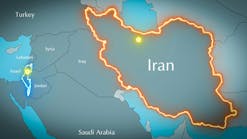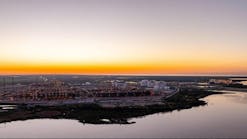Petroleos Brasileiro SA has called for international bids to lay 280 km of dual 14-in. pipelines to handle growing production of oil and gas in Brazil's Amazonas region.
The project is part of a larger, $391 million effort to increase production in the Amazonas region to 45,000 b/d of oil and 210 MMcfd of gas from 20,000 b/d and 70 MMcfd.
Much of this outlay is earmarked for expansion of the Arara oil and gas complex, scheduled to be completed by first quarter 1998.
The Urucu-to-Coari crude/gas dual pipeline system is another step in efforts to implement the recently approved further development of Urucu and East Urucu oil and gas fields in the Amazonas region.
Project details
At the pipeline terminus, near the town of Coari, Petrobras will build the Polo Arara terminal on the Solimoes River, including crude and gas transshipment facilities.
Petrobras' main obstacle in the Amazon is the river system itself, the principal means of transportation in the region. The levels of Amazon tributaries vary widely from June to November, when rainfall is less frequent.
From Porto de Urucu river terminal to the state capital of Manaus, flotillas of barges and river boats take 8-9 days to cover about 900 km (OGJ, Aug. 7, 1995, p. 46).
The oil is currently carried from Urucu by a 10-in., 51-km pipeline to a terminal on the banks of the Tefe River. From there, it is taken by barge to a storage tanker anchored close to the town of Tefe, and from there, shuttle tankers transport it to the Manaus refinery for processing.
This is not a feasible option for larger volumes, because of the shallowness of the river during the dry season.
With the installation of the new pipeline, it will take only 16 hr for the crude oil to travel the stretch from Coari to Manaus by oceangoing vessels. Initially, the gas will be processed, with its liquid petroleum gas recovered and marketed. Later, the gas is to be liquefied and shipped out by cryogenic LNG barges to gas-fired thermal power plants in the cities of Manaus, Porto Velho, and elsewhere in the region.
Located about 600 km from Manaus and 500 km from Porto Velho, the capital of Roraima state, the Rio Urucu region produces a sulfur-free, extremely light 47° gravity oil that yields healthy cuts of the naphtha, gasoline, and diesel that are in short supply throughout the Amazon region. In addition to yielding LPG, Rio Urucu natural gas can also be used to generate electric power, replacing fuel oil in the environmentally sensitive rain forest.
Other infrastructure
In addition to the pipeline, the project involves adding to facilities that will enable Petrobras to increase capacity for production, transportation, and marketing of Amazon oil and gas.
Extending the gathering system, expanding primary oil and gas processing capacity, building a gas processing plant, and increasing gas compression for injection and transportation also are part of the project.
The new natural gas processing plant will have capacity of 210 MMcfd and produce as much as 1,378 cu m/day of LPG, which will be stored in two 3,200 cu m tanks for later shipment along a multi-product pipeline to the Solimoes river terminal.
The existing natural gas processing plant has a capacity of 21 MMcfd and produces 180 cu m/day of LPG that is transported through a 4.5-in. pipeline to the Tefe river terminal for sale to local distribution companies.
Refinery changes
Expanding oil supplies from Urucu are prompting changes at the Manaus refinery.
A new atmospheric distillation unit will be installed at the refinery to increase crude throughput capacity to 50,370 b/d from 15,870 b/d. The added capacity is to come on stream in April 1998, keeping pace with expanding processing requirements for Urucu oil.
This will be timed to coincide with completion of the new Arara complex, to avoid having to process this oil at other refineries at a higher cost.
Construction of this new unit was triggered by the fact that Urucu oil yields cuts of 60% diesel, 30% naphtha, and 10% atmospheric residue.
Construction costs are estimated at $36 million. The project will be handled on a lump sum basis whereby the successful bidder will be responsible for the basic and detailed project design, procurement, construction, commissioning, and start-up.
Increased drilling
Petrobras will start in November a $100 million program to drill 20 wells as part of the overall program to expand production of oil and gas in the onshore Urucu and Jurua regions of the Upper Amazon.
But even before this drilling program was to start, Petrobras reported a significant gas strike in the region.
Its 1 Copaca wildcat flowed on test about 9.3 MMcfd of gas.
Petrobras' preliminary evaluations estimate potential reserves at more than 35 bcf.
More importantly, the find may open a new play, 60 km from the natural gas province of Jurua and 100 km northwest of the oil and gas producing Urucu region.
If this turns out to be an indication of a hydrocarbon-bearing trend extending all the way from the two producing areas, the proved natural gas reserves in the region-a total of 2.9 tcf, or one fourth of Brazil's total-could increase significantly.
The Amazon region has a sedimentary area prospective for hydrocarbons that covers more than 1.8 million square km.
In addition to the producing Solimoes basin, other Amazon region basins of interest are Acre, Amazonas, Parnaiba, Tacutu, Marajo, Sao Luiz, Braganca-Viseu, and Barreirinhas.
Of special interest for oil potential is the deepwater portion of the mouth of the Amazon River.
Copyright 1996 Oil & Gas Journal. All Rights Reserved.

